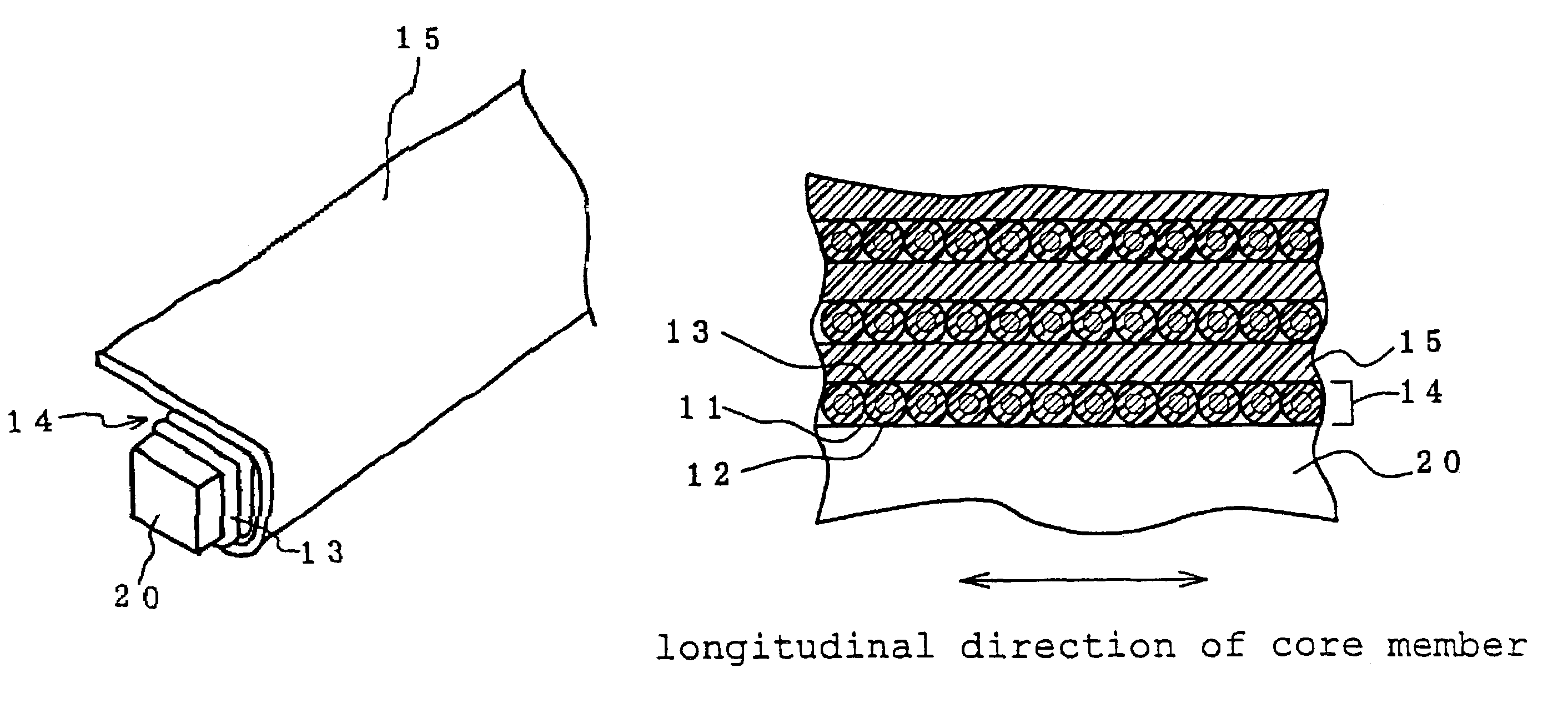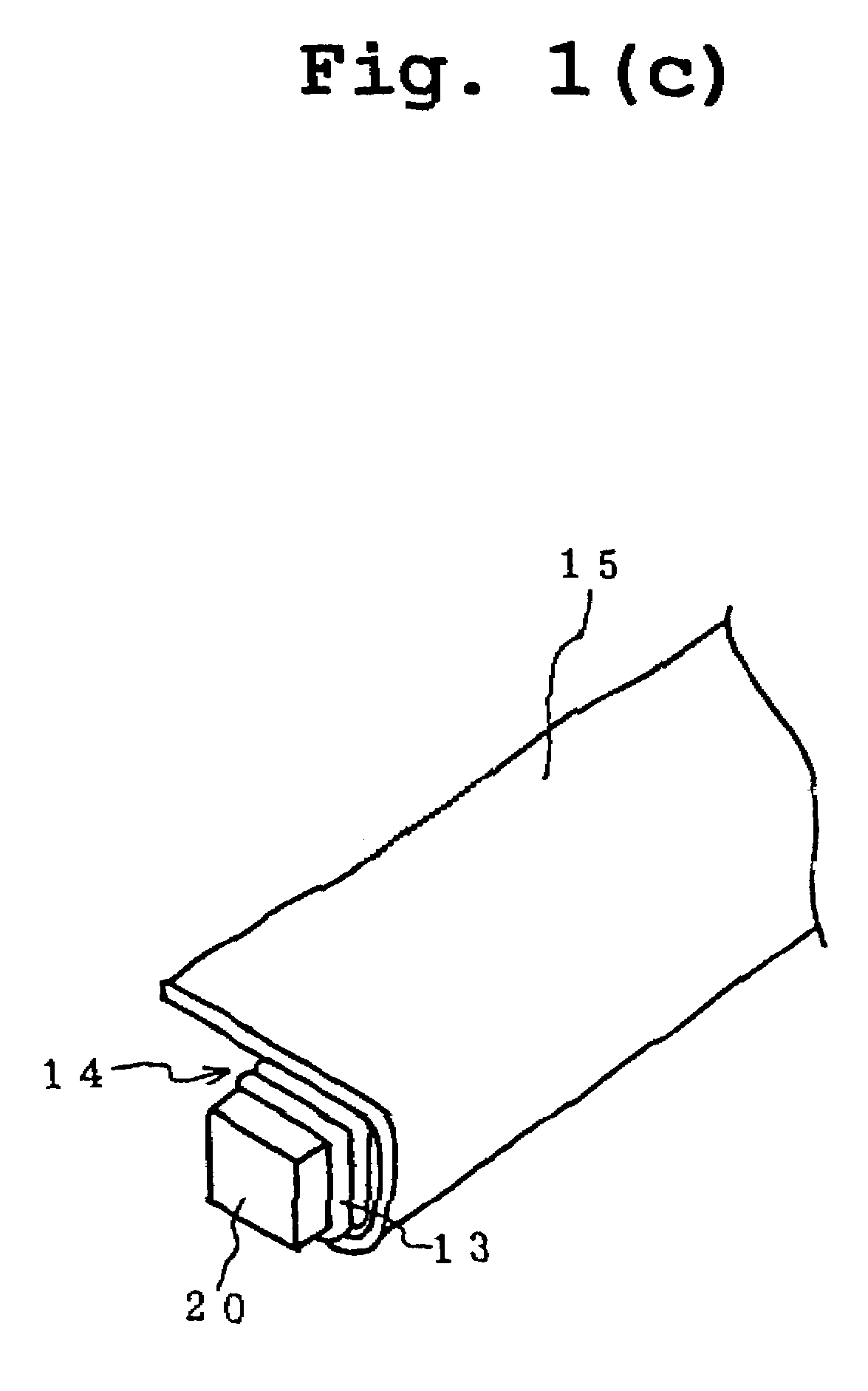Method of manufacturing an anisotropic conductive film
a technology of anisotropic conductive film and production method, which is applied in the direction of conductors, magnetic bodies, coupling device connections, etc., can solve the problems of preventing sufficiently high adhesion to an object, reducing the practicability of the step, and reducing the cost of the necessary step. , to achieve the effect of widening the interval
- Summary
- Abstract
- Description
- Claims
- Application Information
AI Technical Summary
Benefits of technology
Problems solved by technology
Method used
Image
Examples
example 1
[0075]A polyester (manufactured by Toray Industries, Inc., Hytrel (trademark), softening temperature 204° C.) was applied to a Cu thin wire (diameter 18 μm) in a thickness of 4 μm, and the wire was wound to form a single roll layer around a core member (section: 180 mm×180 mm square prism) without forming a space between wires. A 100 μm thick fluorocarbon / acrylic film (manufactured by Denki Kagaku Kogyo K. K., DENKA DX-14™, softening temperature 150° C., elastic modulus 1.3 GPa) was layered on the single roll layer. This process was repeated to give a laminate alternately comprising 50 layers of a winding layer comprising Cu thin wires having a coating layer made from a polyester resin in one row and a fluorocarbon / acrylic film layer. The Cu thin wire of the winding layer was wound while changing the winding position between the odd-numbered winding layers and the even-numbered winding layers in the longitudinal direction of the core member in a closest packing state. This laminate ...
example 2
[0077]A polycarbodiimide resin (obtained by polymerizing 2,2-dimethyl-1,3-bis(4-aminophenoxy)propane (40 g), 3-methyl-1-phenyl-2-phospholene-1-oxide (1.14 g) and p-isopropylphenylisocyanate (2.19 g) in toluene at 80° C. for 2 hr, softening temperature 100° C.) was applied to a Cu thin wire (diameter 18 μm) in a thickness of 7.5 μm, and the wire was wound around the same core prism as used in Example 1 to form a single roll layer without forming a space between the wires. A 50 μm thick thermosetting epoxy film (softening temperature 100 ° C., elastic modulus 2 GPa) was applied on the single roll layer, which process was repeated to give a laminate alternately comprising 100 layers of a winding layer comprising Cu thin wires having a coating layer made from a polycarbodiimide resin in one row and an epoxy film layer. The thermosetting epoxy film used here was obtained by reacting a bisphenol A type epoxy resin with an acid anhydride hardener and a carboxyl group-containing liquid rubb...
example 3
[0079]An amideimide resin (softening temperature 170° C.) was applied to a Cu thin wire (diameter 18 μm) in a thickness of 3 μm, and the wire was wound around the same core member as used in Example 1 to form a single roll layer at a 48 μm interval. A 150 μm thick polycarbodiimide resin film (softening temperature 100° C.) was applied on the single roll layer, which process was repeated to give a laminate alternately comprising 100 layers of a winding layer comprising Cu thin wires having a coating layer made from an amideimide resin in one row and a polycarbodiimide resin film. All the Cu thin wire in the winding layers were wound such that the winding position of each Cu thin wire comes to the same position in the longitudinal direction of the core member. This laminate was made into a block under the conditions of 140° C., 1.96 MPa (polycarbodiimide resin alone softened and flew). The core member was removed and this block was sliced with a wire saw along the plane forming an ang...
PUM
| Property | Measurement | Unit |
|---|---|---|
| softening point | aaaaa | aaaaa |
| outer diameter | aaaaa | aaaaa |
| outer diameter | aaaaa | aaaaa |
Abstract
Description
Claims
Application Information
 Login to View More
Login to View More - R&D
- Intellectual Property
- Life Sciences
- Materials
- Tech Scout
- Unparalleled Data Quality
- Higher Quality Content
- 60% Fewer Hallucinations
Browse by: Latest US Patents, China's latest patents, Technical Efficacy Thesaurus, Application Domain, Technology Topic, Popular Technical Reports.
© 2025 PatSnap. All rights reserved.Legal|Privacy policy|Modern Slavery Act Transparency Statement|Sitemap|About US| Contact US: help@patsnap.com



